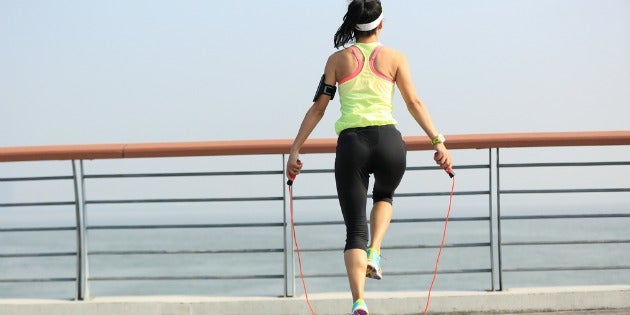Jump On the Fat-Loss Lane

Is there a greater dichotomy in fitness than the jump rope? Think about it: Jumping rope is practiced mostly by fourth-grade girls and pro boxers, with few people in between getting on the double-Dutch bus. But these two demographics perfectly illustrate why everyone should start jumping rope: It’s fun, and it’s a great workout.
Other forms of cardio such as running or stair climbing may help burn fat and build conditioning, but they don’t do much for developing other physical assets or improving sports performance (unless your sport is running or stair climbing). Jumping rope helps agility, balance and footwork, skills that are valuable in any number of sports and all parts of daily life.
The Basics
If you have never picked up a rope before, begin without one. Practice the bound, the short hop that originates from both feet jumping in tandem. Hold your arms out slightly to your sides, with your palms facing forward. Keep your knees slightly bent with only the balls of your feet making contact with the floor. Do not tuck your knees or bring your feet behind you, simply bounce straight up.
Once you progress to using a rope, work on jumping with both feet before starting to alternate feet. Jumping rope is a relatively relaxed exercise. It should not be an explosive jump but rather a compact skip. Keep a light but firm grip on the handles, and make sure you are not jumping too high. There should be no tension in your upper body. Keep your arms relaxed and your shoulders down, and generate the swing through your wrists. Your body will be moving up from the jump as your wrists move down, spinning the rope under your feet.
Here are some guidelines from Buddy Lee, U.S. Olympic wrestler and author of Jump Rope Training (Human Kinetics, 2010) to help you set up:
- Choose a rope that reflects your skill level and goals. Beginners should use a rope with a little weight to it for better control, such as a beaded rope or plastic speed rope. As you improve, switch over to a lightweight PVC core, which is more aerodynamic and quicker. Lighter ropes are better for speed and agility.
- Find the right rope length by standing with one foot in the center of the rope and pulling the ends straight up. The top of the handle should come to shoulder height. Trim your rope to the appropriate length for you.
- Grasp the rope lightly in both hands with your palms facing upward and your wrists lower than your elbows. If your wrists are higher than that, the rope will shorten as a consequence and you’ll likely step on it or trip.
- Keep your upper arms close to your sides with your arms turned away from you about 90 degrees.
The Double-Under
Although skipping rope one turn at a time to the “Janey and Johnny sitting in a tree, k-i-s-s-i-n-g” rhyme is amusing for a little while, you’ll eventually want to kick it up a notch. That’s when double-unders come in.
Double-unders require total central nervous system engagement for improved reaction time and quickness. In addition, the quick bounding action recruits fast-twitch muscle fibers, giving your calves definition and shape while also training explosiveness since you need to jump about twice as high off the ground as you do for single-unders. And when you land, your stabilizing muscles are put to the test eccentrically as they absorb your downward motion.
Mastering the Double-Under
In double-unders, you rotate the rope two full times around your person in a single bound. A little more hang time is required to make that happen without stepping on the rope or thrashing yourself. Here are a few steps that can help you learn how to do them successfully:
- Get proficient at the single-under. Maintain a relaxed posture with your focus forward. Keep your elbows in and your hands at waist height in front of your torso. Turn the rope with your wrists, not your arms. Keep your body long and engaged. Take off and land lightly on the balls of your feet using an even pace. Once you can do 100 to 200 single-unders without a mistake, you’re ready to double things up.
- Jump higher and slower. Give yourself some time to get the rope underneath you twice by doing a “power jump” that’s roughly double the time and altitude of your typical single-under. Remember, your form should stay the same. Practice this power jump with single-unders until it becomes comfortable.
- Integrate the double. For every three single-unders you do, throw in one double-under. Once that becomes easy, do two singles and one double, then one single and one double, then try linking your double-unders.